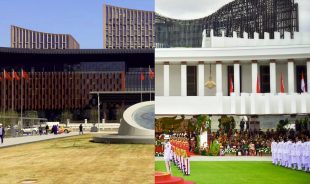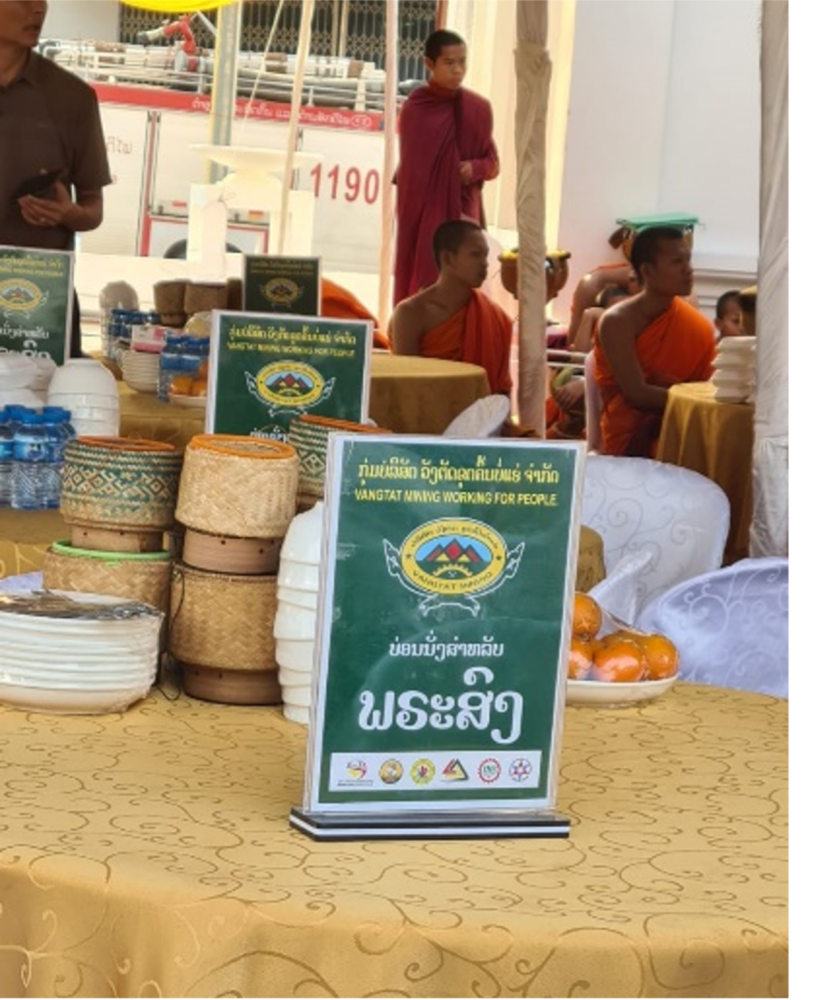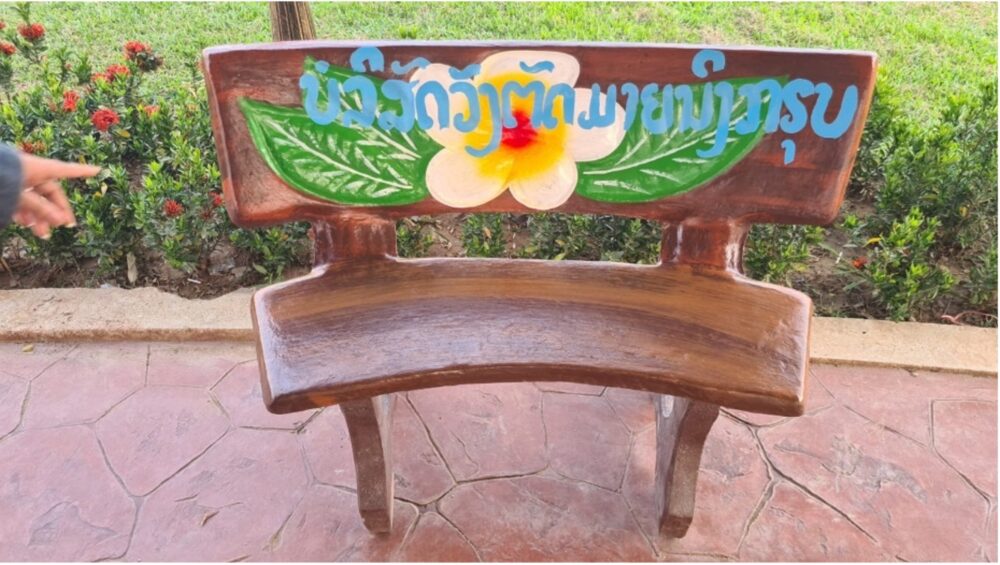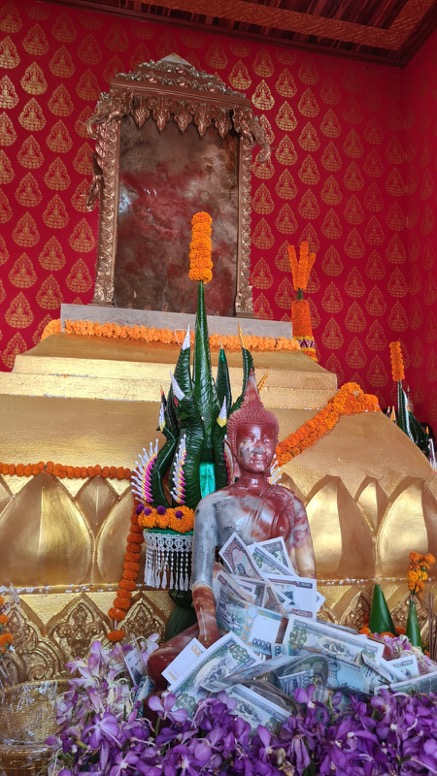On 10 February 2025, my friend Lom (pseudonym) sends me a video clip she took on the street in Attapeu, in the far south of Laos. The video shows a large truck driving past a crowd gathered along the main road of town. I can see mainly women in formal dress: the traditional Lao sin skirt and a shawl worn usually for Buddhist ceremonies. The truck is dressed up, too: waves of white and golden cloth hang along the vehicle’s sides and reflect the sunlight. A red carpet covers the truck’s tray. Five men stand on top; one is resting his hands on a large rock in the middle. Many cone-shaped offerings (ton dok mai) made from rolled banana leaves and marigold flowers surround the rock. Another man on the truck takes pictures of the crowd. Behind the truck rolls a ute with giant speaker boxes that expel Lao instrumental music, announcing the arrival of the rock from afar to the people of Attapeu town.
My friend turns her phone camera to show the destination of the truck: the recently finished City Pillar Park. The City Pillar Shrine, or hall (ho lak muang), will be the new home of this rock, or rather, of the giant gemstone hidden within. The gem will be carved out of its grey coat, lifted up the staircase and past the golden naga (mythical serpent) sculptures that typically guard Buddhist temples.
A few weeks later, over lunch with Lom, I ask her why she thinks this stone is used in the City Pillar. She says that it was “given” by a Chinese company, three large pieces, to three significant places in town. She thinks this occurred so that in the future, when all the stone has been taken, the next generations can still come and see it here. She calls this “kananoulak”, conservation. Another Attapeu friend who I asked told me this was hin on, the Lao term for Pagodite, also known as soap stone which is used in stone carvings and figurines often in religious contexts in China, Japan and Southeast Asia (its name is derived from “pagoda”’). It was found in Phouvong district, Attapeu province, and it is “more expensive than gold!”, my friend says. I ask whether people in Phouvong like to use or sell this stone? She answers: “Yes, people did in the past, but now the government has given all rights to take the stone to international companies. Now it is illegal for Attapeu people to take it.”
Corporate mineral extraction in Attapeu province has rapidly increased over the past few years. In 2022, the Lao government granted ten companies land concessions and mining rights for an area equivalent to a quarter of the province’s land area. A contract to survey for Pagodite in the Phouvong area was signed in February 2023 by the Attapeu provincial government with a Chinese construction company (China is the largest trading partner and investor in Laos). Across the country, investments in mineral production of over US$2.47 billion were made in 2024, and sales of minerals and mineral products yielded more than US$3.2 billion, making minerals the most exported good from Laos. When announcing these numbers in 2025, the Director-General of the Department of Mines Management highlighted the importance of expanding the mineral sector to support Laos’ economic development goals.
At the time Lom’s video reached me, I was at the Paksong agricultural festival, a coffee hub on the Bolaven plateau. Perhaps, what coffee is to the Bolaven, minerals like Pagodite are to Attapeu: a resource that some local people have put their hopes and work in to earn a living, perhaps even gain a slice of wealth. International investors try to make profit from both and have larger bargaining power with the government than farmers. But while coffee trees re-grow, and can support people’s livelihoods ongoingly, Attapeu’s mineral resources are only extracted once, mainly for export. The huge gemstone that travelled into town that day in February, accompanied by traditional music and everyday people’s astonished looks, was perhaps chosen to become part of the new city pillar because of this transience that adds to its material and symbolic value.
In this article, I explore how the stone is wrapped up in stories of spiritual, political and economic powers at play in this province and beyond, which became symbolically “enshrined” in the new Attapeu city pillar. I approach “power” in the sense of power to—that is, generative energies to set things in motion and move people to act—and trace what activities around the Attapeu City Pillar inauguration can tell us about some current flows of power in Laos.
Rather than cast in stone, any spiritual, political and economic powers require ongoing re-generation. Aware of this, the Lao government uses the City Pillar as a vehicle: it revives an ancient practice intended to establish and emplace a spiritual protective power to serve its own contemporary political and economic efforts. A beautiful gemstone is transported from a rural hinterland to the city centre, monks travel to the pillar inauguration event, worshippers gather to show their respect and direct some power towards their own desires, and images feature in government news and on social media—activities the government mobilises to bond citizens to projects of national development and sociocultural integration. Since in the end, as Holly High and Pierre Petit stress, the “state” is made up of people—some of whom we will meet here around the city pillar.
Observations from a city pillar ceremony
Sunday, 27 March 2025. Duan, a hospital nurse in her twenties, picks me up at six in the morning. She is disappointed when she sees the treats I bought, a package of coffee-flavoured lollies: “They are too small for the sai bat (alms-giving ceremony)! And your kathip (rice basket) is too large.” Duan wears a white long-sleeved jacket with delicate stitching, a sin, beige-golden heeled slippers, and a peacock broach holds her long, silky hair together. I feel under-dressed in my Ta Oi (ethnic minority group) sin and cotton shirt. I sense this is a big occasion for her.
We drive the short distance to the City Pillar Park. Attapeu town was busy in the last three days: people from all over the province and further afield travelled to join the inauguration or “worship” ceremony of the Attapeu City Pillar (phithi bouang souang ho lak muang). As the Attapeu Online News writes, it is held to “worship the sacred things and thank the benefactors of the village, city, and nation”.
The construction of the City Pillar Park and shrine took over three years. The celebratory events of the past two days included evening dances and music performances, but the highlight of the festival occurred last night: som phot pha, the night when the Buddha statue of the city pillar is endowed with spiritual powers. This powerful act requires an entourage of senior monks to meditate through the night, alongside laypeople. This morning, scattered rubbish across the park is testimony to the presence of many people who spent the last night here mediating, dressed all in white, and in need of nourishment.
Ideological (mega)projects: Xiong’an and Nusantara
Two problematic planned cities, one postcolonial utopia
We decide to take a walk around the park. On the Northern side of the shrine, tables with chairs stand in the shade of open tents, in readiness for the special guests: local politicians, high representatives of organisations, and important businesses—a category Lao people refer to as “big people” (phou nyai). But today, the most special guests are revered monks who travelled here even from the capital Vientiane, Duan tells me. The signs on the table signify the reserved places for members of the Sangha. I notice on the signs a logo and read: “Vangtat Mining Company Working for the People”. A little further I find benches that also read “Vangtat Company Mining Group” (photos by author below). I learn that these are the main sponsors of this event.
A monk announces the proceedings of the day over microphone, his dark orange robe almost matches the red carpet beneath his feet. Next to him stands a large wooden armchair with flower upholstery. Duan says it’s the Governor’s seat. I keep following Duan who is looking for the best photo spots: this one’s too dark, that one has too many people, that one…she tells me to take photos anyways. I see some people up on the pillar shrine. The doors are open, but I cannot look inside. I ask Duan if we can go up there, but she says that only men can go. That disappoints me; I want to see this stone up close.
We return to our sunny spot. It is now around quarter past seven. A monk begins reciting, and in the same moment, Duan answers her phone. Her colleague is on his way here and wants to know what’s happening. A man with a large camera walks around and films people. He asks a couple of middle-aged women in front of us to take their picture, because they are “phou ngam” (beautiful people). I cover my face with my shawl for some shade. Duan hangs up and stands her phone against her offering bowl so that the camera films her face as she is chanting.
Eventually it is time to “take merit” (ao boun). When the group of monks arrive at our spot, women reach with their arms in between our heads to place their sticky rice, treats and small money notes in the monks’ bowls and trays. These are emptied frequently in large bags carried by young novices. The atmosphere seems jolly: a woman opposite to me jokes with the monk about the sweating she must endure. People attract the monks’ attention by calling out “Ajan” (teacher)—nobody wants to miss out. I ask Duan what this practice means to her. She says it “makes us have happiness” (hai mi khouamsouk). I ask “do the monks give happiness?’ She says, “Yes, they eat our treats, make Amelie and Duan be happy”.
When the last monk has passed us, Duan says “let’s go” and that now we can climb to the top of the pillar shrine, she has seen other women do so. We take off our shoes and leave them beneath the naga railing. It takes a little while for us to approach; many people wait to see the stone inside and take their picture. When we enter the shrine, I see the stone for the first time in its finished rectangular form. It is beautiful with its red, white and grey shades that remind me of flames and smoke rising in a dark sky. In front of the stone sits a Buddha statue made from the same stone, its lap is covered in money notes. We take more pictures, then Duan says it is time to go home, she has some housework to do for her parents.
The pillar and spiritual powers: Buddhas, deities, and spirits
To stress the spiritual significance of the event, the Attapeu Online News wrote that it was a “celebration and consecration, to give merit and praise towards the supreme city pillar deity, master of the place, master of the base, the ancestors, and is a dedication to bring luck to oneself and family to live well and happy”. My friend Ponsavad, a young woman from Attapeu city, consulted her family to explain that the city pillar hall is meant to “serve as an auspicious centre for the city”. They believed that the ritual was performed “to invite sacred deities to come and protect the people in the district”.
The notion of a city pillar deity has been documented by anthropologists of Laos and other Theravada Buddhist countries. Kazuo Fukuura’s research on a community of spirit worshippers of the Chiang Mai city pillar traces the pillar’s origin directly to the Hindu and Buddhist God Indra, more than 700 years ago, after whom the pillar is named. Holly High’s study of myths surrounding the city pillar spirit Lady Si, situated in Vat Si Muang in Vientiane, indicate that the erection of this pillar reaches back as far as 1563 under the rule of King Setthathirat, at which time tradition required the generation of a tutelary deity by human sacrifice.
My friend Souk, who grew up in Attapeu, believed that the custom of a female sacrifice (either voluntary or by murder) when a city pillar was established existed all over Laos. But he was not sure whether there was a previous city pillar in Attapeu, and where it would be located. According to some of the myths High collected, Lady Si’s decision to turn into a spirit by suicide was driven by a desire to spread Dharma, the Buddha’s teaching. For Ponsavad’s family, Dharma also played a role in the city pillar inauguration, as one of “three principal refuges: the Buddha, the Dharma, and the Sangha”, which she told me “are central to our prayers and chants, representing enlightenment, the path of truth, and the community of noble disciples”, also referred to as the “three jewels”.
Creations of and engagements with city pillars employ Buddhist concepts and deities in various ways, and not all Buddhists believe the same. Some people I asked in Southern Laos believed that through a som phot ceremony led by monks and attended by worshippers, the buddha statue within the city pillar would be endowed with protective power. Laypeople might bring their own Buddha statues from home to this event, since before the ceremonial act, they are mere objects. However, when I asked my friend Souk about these beliefs, he said of himself that he tries to follow the teachings of the Buddha, but does not believe in such “magic”. To him, good only comes from people’s actions—the power to affect our lives is within ourselves, not attached to, or radiating from, statues or rocks.
The pillar and political power: Lao nationalism and socialism
Spiritual powers of city pillars are entwined with the political power of the muang (a traditional city state, predating the nation), such as Vientiane or Chiang Mai, a term today used in Laos to refer to a city or district. John Clifford Holt, a historian of Buddhism in Laos, writes that Buddhist political power in Laos consolidated not until the 16th century (the time when the Vientiane City Pillar was established), and was influenced from the neighbouring Lan Na kingdom, today’s Chiang Mai region. Buddhism re-entered the official Lao historiography after a phase of initial marginalisation of religion under the socialist regime. Laos’ more recent city pillars are created with the intention to strengthen a sense of national unity and incorporate Buddhism. Whilst regional, provincial sentiments of belonging and pride are tapped into, the intention is to instil pride in the Lao nation as a whole.
The pillar as an “historical and cultural symbol of the province”, as the Attapeu Online News write, thereby feeds into modern Laos’ socialist political culture, where selected notions of history and heritage of “good and beautiful customs” are evoked to enhance a sense of unity and nationhood amongst the “multi-ethnic Lao people”. When the Lao People’s Democratic Republic was established in 1975, Kaysone Phomvihane, leader of the Pathet Lao liberation movement, declared unity of the country a priority and, as Goudineau writes, ‘defended polyethnic solidarity in the context of a single and indissoluble Lao nation.’
Constructions of a national Lao culture to support unity are ongoing and the recent revival of city pillars are part of this nation-building-project. In 2012, a new pillar shrine was established in the national capital, Vientiane, not far from the landmark Vat Si Muang temple. Goudineau describes this as an act to regain “symbolic control”: a plaque at the pillar that I visited in May 2025 claims this to be the site of an ancient city pillar erected in 1540, under the reign of King Phothisarat of the Lan Xang Hom Khao Kingdom (the land of the One Million Elephants and the White Parasol), hence before Lak Si Muang appeared under Photsirath’s son Setthathirat.
Ideological (mega)projects: Xiong’an and Nusantara
Two problematic planned cities, one postcolonial utopia
As the newest addition, Attapeu’s City Pillar Shrine is described in local news as “preserving culture and enhancing the unity of local people” (note, that people from at least ten recognised ethnic groups live in Attapeu, in a population of around 160,000 in 2024). In his speech at the procession for moving the soap stone to the new city pillar hall on 10 February 2025, the provincial governor praised the “participation” and “cooperation of people of all ethnic groups in Attapeu” in a procession that “shows solidarity, love, and devotion to the good traditions, culture, and customs of the nation and the tribes in the land of Attapeu province”. He compared the beauty and complexity of the stone to Attapeu where many ethnic groups live together.
Multiculturalism has gained some symbolic traction in Lao politics, which becomes especially apparent in Sekong’s city pillar, Attapeu’s neighbouring province. This pillar is surrounded by scenes of village work carved in stone, and ten statues of male-female couples accentuate (or fantasise?) differences in dress and tools deemed typical for their ethnic group identified by plaques. Here, the Lao couple is presented as standing alongside, and in line, with others who appear to guard the pillar.
Yet, despite such government-initiated showcase of multi-ethnicity, there is a widespread sense that on national scale, the Lao-Tai population remains dominant in defining what makes up “being Lao.” Researchers of Laos have critiqued the government’s efforts to create unity as “Laoization” of ethnic minorities who are encouraged to resemble the livelihoods, cultural and spiritual outlooks of Buddhist, Lao-Tai people. The establishment and ceremonies surrounding the Attapeu City Pillar may be seen as part of this political project of social integration on provincial level, sending the message that worshipping the pillar-deity is important to all people of Attapeu, if not Laos. Spending this event with my friend Duan, I got a sense that the aesthetic performance of a devote, Lao Buddhist woman with bright skin may add to one’s cultural capital in her society, prompting to post her religious participation on social media.
The pillar and powers of socioeconomic development
The message of unity sent out during the Attapeu city pillar inauguration is not only socio-political but has also an important socio-economic dimension. Memorabilia of economic, corporate power were scattered around the place, from VIP table signs to public benches that carry the name of the Vangtat mining company. Mixing economics and religion, the corporation’s representatives were named as benefactors of Attapeu in the monk’s speech prior to the alms-giving ceremony.
Established in Attapeu’s Sanxai district in 2009, the Vietnamese Vangtat Mining Company Ltd. Contributed to a further ”boost” in gold mining in Laos around 2019. In 2022, Vangtat received government approval to explore an area of 399.1 km2 and exploit 18 km2, with a target of 1,000,000 tons of rare iron ore, and 30,000 tons of rare earth minerals in Attapeu’s neighbouring Sekong province. According to a Radio Free Asia report, Vangtat had explored and mined 428 km2 by mid-2024 in Southern Laos. Investments and beneficiary often go hand in hand, and Vangtat recently made the government news for a 20 million kip sponsorship payment towards Laos’ ASEAN chairmanship.
According to the Lao Ministry of Energy and Mines, mining projects must ensure three benefits: of the nation, of investors, and of the local area. The latter is especially controversial. Residents in the district where the city pillar stone was mined said in an interview to Radio Free Asia that mining in their region disrupted livelihoods by causing damage to roads, traffic and noise, and limited access to farmable land. Wages paid to local workers were considered too low. People found it hard to see the benefits for the local area that their government promises, and lamented a lack of monitoring for social and environmental impacts by officials based in the faraway provincial centre.
Official statements instead spread narratives of cooperation, harmony and mutual benefit between mining companies and local communities. In the speech of Attapeu’s Provincial Governor in the local news on the day the nearly ten ton heavy soap stone was moved to the city pillar shrine from Phou Kang Hong, Phouvong District, he stresses his pride in seeing the peaceful cooperation between the Lao–China gemstone development company and Attapeu’s “multi-ethnic People”. These narratives are situated within the wider development ideology of the Lao People’s Revolutionary Party. Five-Year Development plans are underpinned by a revolutionary mission of guiding and reforming the population through a socialist path: in essence, the population is supposed to unite in harmony and cooperate to realise development plans.
This narrative of national development is instilled throughout education, as I observed myself in politics classes during my PhD fieldwork at a state-run tertiary education institute. The government’s vision of national socioeconomic progress demands the population to make sacrifices; those considered “lagging behind” (commonly ethnic minorities) are requested to relocate and change their agricultural methods to what is deemed more innovative. As harbingers of modernisation, international investments into the country’s resources and infrastructural development are celebrated in official news; every deal is portrayed as testimony for socioeconomic progress. I found that many physical structures in Attapeu—new hospitals, an airport, and now a city pillar—were built with international, corporate money in exchange for land concessions or resource extraction deals. In Attapeu, investors such as the Hoang Anh Gia Lai Group employ the same narratives as aid organisation, promising to “reduce poverty” and “eliminate hunger”.
Ideological (mega)projects: Xiong’an and Nusantara
Two problematic planned cities, one postcolonial utopia
Heritage and powers enshrined
City pillars in Laos attempt to preserve a piece of tangible wealth or heritage of a region that over its tumultuous history sacrificed a lot, long before it called itself a nation. Vientiane’s monument is said to host ancient relics that escaped pillaging from Siam, French colonisation, and American imperialism. Attapeu’s city pillar shrine now holds one exemplar of a sought-after stone, mined by and exported to its more powerful neighbours, mainly China and Vietnam. Though some commentators have described the current political-economic dynamics neocolonial, it is not as simple as depicting Laos as victim. Danelle Tan argues that, by attracting economic powers such as China, the Lao government manages to maintain its own power, whilst “the minorities, the farmers and the poor” bear the costs.
Attapeu’s new city pillar stands there to celebrate, not to mourn, the treasures of the province. One big, shiny piece is now enshrined to be preserved for generations—“heritage” has been declared. In the governor’s words, as a “priceless” mineral, the stone symbolises the “abundance and wealth of the land and water resources of our Attapeu province”. For some, it may just be a dead rock hidden away. For others, who live in or can travel to the centre of the province, and participate in activities of worship like Duan and I, the soap stone block and Buddha may regenerate spiritual, political and economic powers—as well as more mundane hopes for happiness—that reverberate far beyond Attapeu.
The post Attapeu’s new city pillar: worship, develop, unite! appeared first on New Mandala.
This post was originally published on New Mandala.




